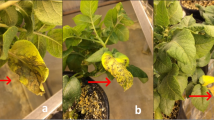Summary
The investigation dealt with the question, whether after self-pollination active pollen cutinase is irreversibly inactivated, or if after cross-pollination, inactive pollen cutinase is irreversibly activated. To answer this question, a short time after pollination pollen grains of the self-incompatibleCruciferae speciesArabis arenosa andBrassica nigra were transferred onto a second stigma with other incompatibility genes and their behavior observed. The pollen grains were used under the following pollination conditions: I. crossing → crossing (control), II. selfing → crossing, III. selfing → selfing (control), IV. crossing → selfing. While the two controls indicated that the reaction of pollen is not changed by the mode of transfer, penetration of the pollen tubes into the second stigma (selfing) could be observed in combination IV.
This result suggests an irreversible activation of pollen cutinase by the first stigma (crossing). Because under favourable conditions only short contact of the pollen grain with the stigma is necessary for the activation of cutinase, we suppose that the reaction which induces activity of cutinase takes place between specific structures situated in the wall of pollen grain and papilla.
The question whether activation and blockage of activation of the cutinase system is dependent on S-alleles is discussed in connection with the concept ofSampson (1962) on „species-area“- and the „S-allele-area“-combination between pollen and stigma.
Zusammenfassung
Anlaß für die Untersuchung war die Frage, ob eine aktive Pollencutinase nach Selbstbestäubung irreversibel inaktiviert, oder ob eine inaktive Pollencutinase nach Kreuzbestäubung irreversibel aktiviert wird. Zur Beantwortung dieser Frage wurden Pollenkörner der selbstinkompatiblen CruciferenartenArabis arenosa undBrassica nigra kurze Zeit nach Bestäubung auf eine zweite Narbe mit anderen Inkompatibilitätsgenen übertragen und ihr Verhalten beobachtet. Die Pollenkörner wurden unter folgende Bestäubungsbedingungen gebracht: I. Kreuzung → Kreuzung (Kontrolle), II. Selbstung → Kreuzung, III. Selbstung → Selbstung (Kontrolle), IV. Kreuzung → Selbstung. Während die beiden Kontrollen zeigten, daß der Pollen durch den Vorgang des Übertragens in seiner Reaktion nicht verändert wird, war bei der Kombination IV ein Eindringen der Pollenschläuche in die zweite Narbe (Selbstbestäubung) zu beobachten.
Dieses Ergebnis spricht für eine irreversible Aktivierung der Pollencutinase durch die erste Narbe (Kreuzbestäubung). Da für die Aktivierung der Cutinase unter günstigen Umständen nur ein kurzer Kontakt des Pollenkorns mit der Narbe notwendig ist, nehmen wir an, daß sich die Reaktion, welche die Cutinasetätigkeit auslöst, zwischen spezifischen, in der Wand von Pollen und Papille gelegenen Strukturen abspielt. Die Frage der S-Allel-Abhängigkeit von Aktivierung und Blockierung der Aktivierung des Cutinasesystems wird im Zusammenhang mit der Vorstellung vonSampson über das Zustandekommen einer “Species-Areal”-Kombination und einer “S-Allel-Areal”-Kombination zwischen Pollen und Narbe diskutiert.
Similar content being viewed by others
References
Christ, B.: Entwicklungsgeschichtliche und physiologische Untersuchungen über die Selbststerilität vonCardamine pratensis. Z. Bot.47, 88–112 (1959).
Kroh, M.: Genetische und entwicklungsphysiologische Untersuchungen über die Selbststerilität vonRaphanus raphanistrum. Z. Vererbungsl.87, 365–384 (1956).
Kroh, M.: An electron microscopic study of the behavior ofCruciferae pollen after pollination. In:H. F. Linskens (Editor), Pollen Physiology and Fertilization, 221–224 (1964).
Linskens, H. F., und W.Heinen: Cutinasenachweis in Pollen. Z. Bot.50, 338–347 (1962),
Reimann-Philipp, R.: The application of incompatibility in plant breeding. In:S. J. Geerts (Editor). Genetics Today3, 649–656 (1965).
Sampson, D. R.: Intergeneric pollen-stigma incompatibility in theCruciferae. Canad. J. Genet. Cytol.4, 38–49 (1962).
Sears, E. R.: Cytological phenomena connected with self-sterility in flowering plants. Genetics22, 130 (1937).
Tatebe, T.: The effect of the multilation of stigmas on self-fertility in the Japanese radish. J. Hort. Assoc. Jap.10, 62–65 (1939).
Author information
Authors and Affiliations
Rights and permissions
About this article
Cite this article
Kroh, M. Reaction of pollen after transfer from one stigma to another (contribution to the character of the incompatibility mechanism inCruciferae). Züchter / Genet. Breed. Res. 36, 185–189 (1966). https://doi.org/10.1007/BF02394157
Issue Date:
DOI: https://doi.org/10.1007/BF02394157




